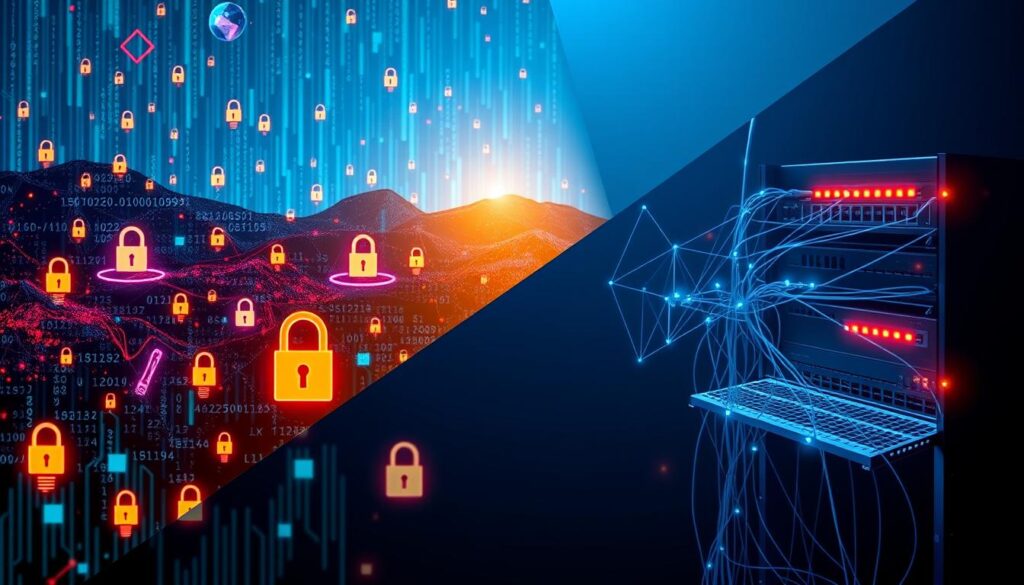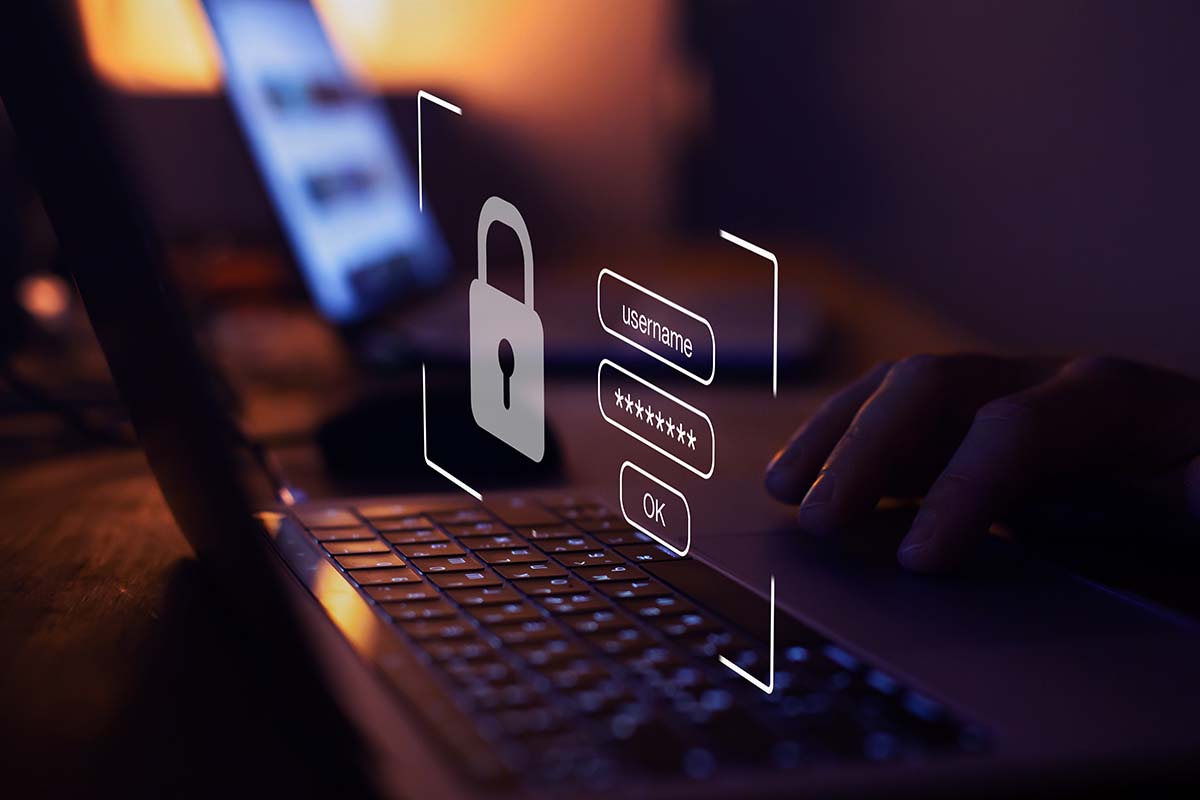Cybersecurity vs Network Security: What’s the Difference?
In today’s world, cybersecurity and network security are key for businesses. They share some similarities but have big differences in focus and challenges. We’ll look at what makes them unique and how Ark Solvers can use them to protect their digital stuff and data.
Ever thought about what makes cybersecurity and network security different? Are they just the same thing with different names, or do they need different strategies and skills? We’ll answer these questions as we explore the details of these important information protection areas.
Key Takeaways
- Cybersecurity protects digital assets, while network security keeps the infrastructure safe.
- Cybersecurity fights threats like malware and hacking, while network security fixes network problems.
- Protecting data well means using both cybersecurity and network security together.
- Rules and laws often cover both areas, so a complete security plan is needed.
- Ark Solvers need to know the differences and how they work together to make strong digital spaces.
Understanding the Cybersecurity Landscape
In today’s world, cybersecurity is a big deal for everyone. It’s important for people, companies, and governments. Cyber threats like malware and phishing attacks can harm our digital systems and steal our private info. To fight these threats, cybersecurity has changed a lot, bringing new tools and ways to keep us safe.
Read More: What is Cybersecurity? Types, Threats, and Cyber Safety Tips

Cyber Threats and Risks
Cyber threats include viruses and ransomware, among others. These threats can steal data, mess up systems, and cost money. It’s key for companies to know about these threats to protect their online stuff.
The Evolution of Cybersecurity
As cyber threats grow, cybersecurity experts have come up with new ways to fight them. Things like better encryption and systems to stop intruders have improved a lot. Laws like GDPR and HIPAA also help by making data protection a top priority.
Knowing about cybersecurity helps companies protect their online assets. Taking steps like managing vulnerabilities and following the law is crucial. This way, companies can stay one step ahead of cyber threats and keep their customers’ trust.
Network Security: Safeguarding Your Digital Infrastructure
In today’s digital world, keeping your network safe is key to protecting your business. Cybersecurity protects your data and digital stuff. But network security keeps your network safe, letting you send data and talk without problems.
Network security uses many steps to stop unauthorized access and control data flow. It makes sure your network is reliable and always there for you. Experts work hard to keep your digital world safe, from the hardware like routers to the rules for sending information.
Key parts of network security include:
- Firewall configurations: Firewalls control what goes in and out of your network. They make sure your network follows security rules.
- Network monitoring: Watching your network all the time helps find weak spots and catch odd behavior right away.
- Encryption techniques: Strong encryption keeps your data safe as it moves through the network.
- Security policies: These rules help put together and keep up with network security steps, making sure everything works well together.
By fixing weak spots and following best practices, companies can protect their digital world. This helps fight off new threats.
Read More: What is Network Security? Definition, Importance, and Types
Cybersecurity vs. Network security
Cybersecurity and network security are often mixed up, but they’re really different. Cybersecurity is all about keeping out hackers and protecting data from threats. Network security is about keeping the network safe and controlling how data moves inside an organization.
Defining the Key Differences
Cybersecurity is a wide field that uses many strategies and tech to protect digital stuff like data and apps from bad guys. Network security is more focused. It’s about keeping the network safe, including things like routers and firewalls, to keep data safe and secure.
Overlapping Responsibilities
Cybersecurity and network security often work together. Weak spots in the network can be targets for cyber threats. For instance, checking for vulnerabilities can show where the network is open to attacks. Also, making sure an organization follows security rules helps keep the network and data safe.
To wrap it up, cybersecurity and network security are both important but work together. They help protect an organization’s digital stuff and keep it safe overall.
Data Protection: A Shared Priority
In today’s digital world, keeping data safe is key for both cybersecurity and network security. It’s important to protect sensitive data’s confidentiality, integrity, and availability. Encryption and access controls are two main ways to do this for all kinds of organizations.
Encryption and Access Controls
Encryption is vital for keeping data safe while it’s being sent over the internet. It makes the information unreadable to anyone who shouldn’t see it, even if they intercept it. Access controls, like strong login systems and setting who can see what, also play a big role.
These tools work together to protect against both inside and outside threats. By using encryption and access controls, companies can lower the chance of data theft and keep their important information safe.
Firewall Configurations and Network Monitoring
Firewalls are key in network security. They control what goes in and out of a network. Having the right firewall configurations is crucial for strong network security protocols.
Along with strong firewall security, watching the network closely is important. This helps spot and stop unauthorized access or strange actions. It shows if there might be a threat.
Having a good monitoring system keeps organizations alert and ready for new cyber threats. By using smart firewall configurations and active network monitoring, companies can improve their security. This helps protect their digital stuff better.
- Check and update your firewall configurations often to keep up with new threats.
- Use strong access controls and checks to stop unauthorized people from getting into your network.
- Keep an eye on network traffic and actions to catch and deal with security issues fast.
- Use advanced analytics and threat detection tools to improve your network monitoring.
- Test and check your security often to make sure it works against new cyber threats.
Being alert and proactive with firewall configurations and network monitoring helps protect your digital stuff. It lowers the risks of cyber threats.
Intrusion Detection and Prevention Systems
Intrusion detection systems (IDS) and intrusion prevention systems (IPS) are key to keeping networks safe. They help spot and stop threats to an organization’s digital world.
Identifying and Mitigating Threats
IDS and IPS watch over network traffic and system actions. They catch and act on threats right away. By looking at network data and system behavior, they spot unauthorized access and other odd activities. This lets companies act fast to lessen the damage from security issues.
- Intrusion detection systems (IDS) keep an eye on network traffic and system logs, warning security teams of any odd activity.
- Intrusion prevention systems (IPS) do more, stopping threats from harming the network and devices connected to it.
- Having good plans for responding to incidents and detecting threats is key for companies to deal with security breaches quickly and well.
Using strong IDS and IPS helps companies boost their cybersecurity and network security. This makes them ready to find and stop threats before they can do a lot of harm.
Vulnerability Management and Risk Assessment
Managing vulnerabilities and assessing risks are key to keeping networks and systems safe. By finding and fixing weaknesses before hackers can exploit them, companies can lower the chance of attacks. For Ark Solvers, strong vulnerability management and detailed risk assessments keep them ahead of threats and protect their digital assets.
Proactive Measures for Ark Solvers
Ark Solvers must be proactive in managing vulnerabilities and assessing risks. They need to scan for weaknesses, figure out how they could be used, and fix them quickly. By always watching their systems, Ark Solvers can cut down on cyber attacks and keep their important data safe.
- Do regular vulnerability assessments to find and sort security gaps in the network and systems.
- Use a detailed risk management plan to see how big a risk a weakness might be and come up with ways to lessen it.
- Have automated vulnerability management steps to fix weaknesses fast when they’re found.
- Keep checking and updating risk assessment methods to keep up with new threats and business needs.
By taking these steps, Ark Solvers can make their security better, lower the chance of cyber attacks, and protect their digital assets.
Read More: Different Types of Cyber Security: A Comprehensive Guide
Compliance and Regulatory Requirements
Cybersecurity and network security go beyond just tech solutions. They also mean following laws and standards. Companies must make sure their security matches up with laws and best practices. This helps avoid legal, financial, and reputation problems.
Keeping up with compliance is a team effort between cybersecurity and network security teams. It’s about protecting digital assets and keeping an organization’s digital setup safe. Laws like GDPR, HIPAA, and PCI DSS set rules for protecting sensitive info and stopping data breaches.
Following these rules shows a company cares about keeping data safe and secure. It helps avoid big fines and legal trouble. Plus, it builds trust with customers and others.
Key Compliance Considerations
- Implementing strong access controls and encryption for sensitive data
- Regularly checking and updating security policies and steps
- Doing risk assessments and testing for vulnerabilities
- Training employees on security best practices
- Keeping detailed records and audit trails to show compliance
Companies need to keep up with new laws and standards. This helps them stay safe and avoid risks from not following the rules. By focusing on compliance, companies make sure their security plans work well and are legal and morally right.
Incident Response and Disaster Recovery
When a security incident happens, like a data breach or network attack, both cybersecurity and network security teams must work together. They use incident response and disaster recovery plans. These plans help detect, contain, and lessen the impact of incidents. They also guide how to get operations back to normal.
Preparedness is Key
Being prepared is crucial for handling incidents and recovering from disasters. Organizations ready to face security incidents can reduce damage and bounce back faster. They review and update their plans often, do simulations, and train their teams.
Good incident response plans should have these parts:
- Steps to detect and analyze incidents
- Strategies to stop the incident from spreading
- Actions to get rid of the incident’s cause
- Steps to recover and get back to normal
- Reviewing after incidents to learn from them
Disaster recovery plans also need to cover data backup, system restoration, and keeping the business running. This ensures the organization can keep up critical operations after a big disruption.
Investing in strong incident response plans and disaster recovery helps organizations stay strong. It’s key in today’s fast-changing threat world.
Integrating Cybersecurity and Network Security
Organizations need to blend their cybersecurity and network security plans for strong security. This means making sure security rules match, working together on how to respond to incidents, and using the same access controls across the digital world.
By taking a full view of security, Ark Solvers can make their digital world safer. They can guard against many threats with network security solutions, security policies, incident response, and access controls.
Aligning Security Policies
It’s key to match security rules between cybersecurity and network security teams. This makes sure security steps are the same everywhere, lowering the chance of weak spots that bad guys could use.
Incident Response Coordination
Working together on incident response plans helps cybersecurity and network security teams react better to security issues. This way, they can spot, stop, and fix threats fast and well.
Consistent Access Control Implementation
Using the same access controls everywhere is vital. This means only those who should see important data and resources. It cuts down the risk of unauthorized access and data leaks.
By making sure security rules, incident responses, and access controls are the same, organizations can get better at keeping their digital stuff safe. This helps them fight off many threats.
Conclusion
In today’s digital world, combining cybersecurity and network security is key. This blend helps protect digital assets, data, and infrastructure from cyber threats and network vulnerabilities.
Cybersecurity fights against threats like malware and hacking. Network security secures the digital setup, including firewall configurations, intrusion detection, and prevention systems. Together, they protect data and systems fully.
As threats and vulnerabilities grow, Ark Solvers must stay alert. They need strong security policies and a proactive incident response plan. By using both cybersecurity and network security, organizations can face the digital world’s challenges. They protect their assets and stay strong for the future.
FAQ
What is the difference between cybersecurity and network security?
Cybersecurity protects digital systems and data from threats. Network security secures the infrastructure for digital communication and data transfer. Cybersecurity fights off cyber threats like malware, while network security keeps the network safe and reliable.
Are cybersecurity and network security the same thing?
No, they’re not the same, but they work together. Cybersecurity focuses on digital threats, while network security protects the network’s infrastructure. They often overlap, as cyber threats can use network weaknesses.
Which is better, cybersecurity or network security?
Neither is better alone. They protect different parts of an organization’s digital world. A good security plan uses both cybersecurity and network security together.
What is the relationship between information security, cybersecurity, and network security?
These fields are related but different: – Information security protects all types of information. – Cybersecurity focuses on digital systems and data threats. – Network security secures the network and communication protocols.
What are the key components of network security?
Key components include firewalls to control network traffic, monitoring for suspicious activities, systems to detect and prevent threats, encryption to protect data, access controls to limit unauthorized access, and security policies to guide network use.
How do cybersecurity and network security work together?
They work together in several ways: – Cybersecurity uses a secure network to be effective. – Network security helps fight cyber threats. – Both teams work together on incident response and recovery. – Combining strategies improves overall security and protects digital assets.
What is the role of compliance and regulations in cybersecurity and network security?
Following laws and standards is key for cybersecurity and network security. It helps avoid legal issues and protects the organization’s reputation. Both teams work together to keep up with compliance.






